Siphon for washing: design, purpose, do-it-yourself installation features
One of the most important elements of home water supply systems is the sink siphon.It not only removes used water, eliminating the risk of flooding, but also protects residents from harmful sewer odors, preventing them from spreading indoors.
In order for the device to cope well with its immediate tasks, you need to choose the model that is most suitable in all respects, weighing the pros and cons of the presented variations.
The content of the article:
Structure and principle of operation of devices
Siphons, regardless of their type, have approximately the same design and a similar operating principle. They are a metal or plastic pipe or a pipe system that includes pipes and a tank.
On one side, the devices are connected to the drain opening in the sink, on the other, they are connected to the sewer system. The used water flows into the siphon, then passes through the pipe and enters the general sewer riser.
The system is protected from clogging by a mesh filter located at the sink opening. The slightly curved shape is given to the siphon for a reason: a certain volume of liquid is retained at the bend, forming a so-called water seal. It is this that prevents unpleasant odors from getting inside from the sewer.

The standard equipment set includes the following elements:
- metal grate for drainage - the optimal cell diameter is no more than 10 mm;
- inlet/outlet pipe;
- connecting screw with a diameter of up to 8 mm;
- frame;
- union nuts;
- sewer outlets;
- O-rings for sealing joints.
If the siphon is equipped with an overflow function, then the package includes an additional pipe, which is attached to the overflow hole in the sink.

Some models have special side fittings for connecting hoses of household appliances (washing machines, dishwashers). Products for sinks with two bowls are equipped with a duplicate outlet.
What materials are the devices made from?
Various materials are used in the production of siphons. Each of them has its own advantages and disadvantages. When choosing a suitable device, it is important to make sure that the material from which it is made is quite durable, resistant to corrosion and oxidation. Its service life depends on these characteristics.
Available plastic products
Plastic siphons are the cheapest and most common devices with a simple design and a small number of connections.
Devices are made from PVC, polyethylene, polypropylene. The latter option is preferable, as it lasts longer, has better strength and is less sensitive to high temperatures.
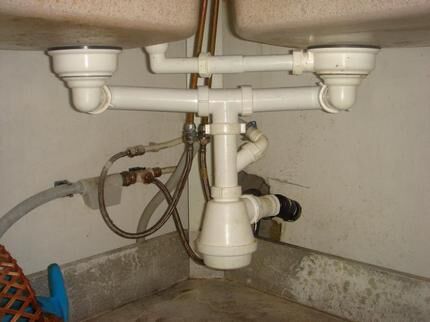
Thanks to the smooth and even inner surface, impurities contained in the water are not deposited on the walls. Some manufacturers apply antibacterial coatings to the cavity to prevent strong sedimentation of dirt and grease.
Plastic products are very flexible. Most of them are equipped with bendable corrugated bends, which quickly take the shape required for installation.
Durable metal devices
In the manufacture of metal products, brass, bronze, copper, and chrome plating are used. They stand out for their stylish design, which perfectly complements luxury interiors.
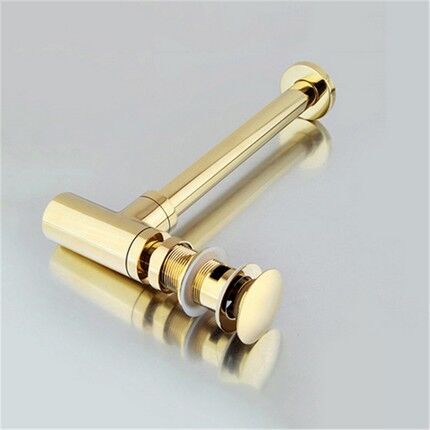
It should be taken into account that metal pipes require precise sizing during installation, they are difficult to shorten, and maintaining the original appearance takes a lot of time and effort.
Such devices are more appropriate in bathrooms, where they will be visible, performing a decorative function.
Types of plumbing products
There are several types of siphons used for installation on a sink. Which one is better to choose depends on the budget, the nuances of the location of the sink in relation to the sewer outlet, and the requirements for the functional part.
Simple corrugated designs
The most basic type of device is a folded corrugated plastic tube placed on a movable frame base. To obtain a water seal, such a siphon is bent in the desired direction, and the bend area is fixed with plastic clamps.
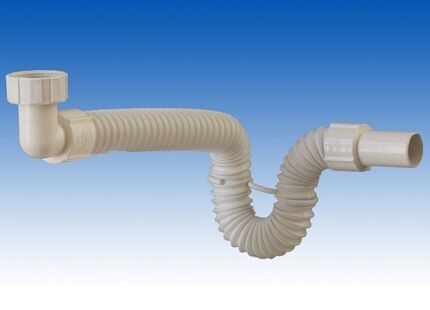
Due to the fact that the soft pipe easily changes position and shape, it can be mounted anywhere. The corrugation is easy to assemble and has a budget price.
Its main disadvantage is its integral design, which does not include separate prefabricated elements. This makes it difficult to clean the product, which is prone to the accumulation of fatty deposits. In cases of severe contamination, you won’t be able to get by with a regular tube: you’ll have to tinker a lot, taking the time to completely disassemble the system.
When choosing a corrugated siphon, you should take into account that it is not suitable for working in cold rooms, for example, in a summer kitchen that is not heated in winter. In addition, the product begins to quickly deform from frequent drains of boiling water into the sink.
Convenient bottle-type devices
Bottle or flask devices are a type of siphons for washing, characterized by a rigid design. In their lower part there is a vertical vessel with an outlet pipe inside, which looks like a bottle.
It constantly contains fluid that provides functions effective water seal.
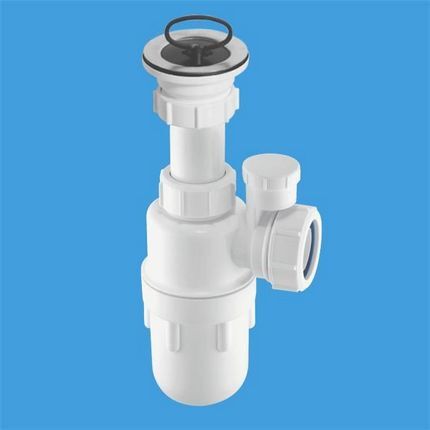
Compared to corrugated devices, they are much more difficult to install and disassemble, but they are much easier to clean from accumulated blockages. Additional equipment can be connected to them using splitters and fittings.
A useful feature of the structure of some bottle siphon models is presence of overflow, thanks to which the liquid level is controlled and the sink is prevented from overflowing.
Bottle siphons also include compact flat siphons, ideal for installation in any hard-to-reach place.
Reliable pipe options
Pipe-type plumbing equipment - collapsible and non-dismountable models, made in the form of a rigid curved pipe.
The collapsible structure consists of pipe sections connected in a certain order. It requires the most accurate comparison of the sink outlet opening and the sewer drain hole. The functions of the water seal are assigned to the curved section of the device in which water is collected.
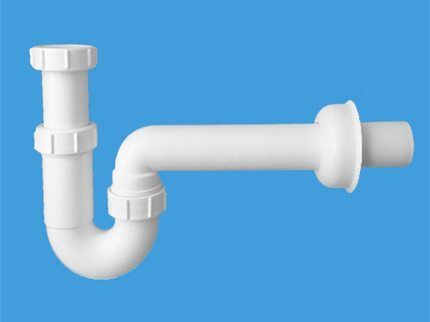
Pipe siphons can be additionally equipped with overflow devices and sockets, which allows installation on double kitchen sinks. The main advantage of the products is increased strength. At the same time, they are immobile and rather bulky, and this limits installation options in limited space.
Debris particles in pipe siphons fall to the lowest point of the structure. Typically, the cleaning procedure is accompanied by characteristic difficulties, not counting the improved models with an easily removable elbow.
DIY Installation Instructions
Connecting a siphon to a sink is a relatively simple task. Anyone can certainly cope with it without the help of a master plumber. However, this matter should be approached responsibly, since neglect leads to a number of negative consequences - leaks under the sink, stench, etc.
Dismantling the old device
When planning to replace the siphon, you need to carefully dismantle the device that has served its purpose before proceeding installation of a new product. Holding it from below, use a screwdriver to unscrew the screw located in the center of the drain grille. Then all that remains is to disconnect the pipe from the sewer pipe.
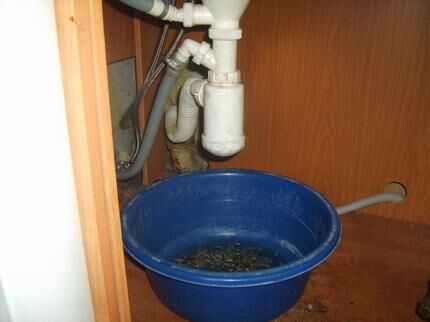
During the dismantling process, many people have difficulty removing the screw. Over time, it often becomes tightly attached to the nut. The problem is solved by removing the lower part of the equipment and turning the pipe. In advanced cases, you will have to use powerful chemical solvents.
For further work, it is necessary to prepare the sewer socket by thoroughly cleaning its internal surface. It is important to follow safety precautions by wearing latex gloves and a petal respirator.
If the pipe is cast iron, you may need a small hammer and chisel. After cleaning, it is better to cover the opening of the bell with a moistened rag or a cork of suitable size for the duration of the installation procedures.
Features of assembly and installation
Before starting installation, it is recommended that you read the instructions for the purchased product in detail, check the availability and ensure the integrity of all components. There should be no cracks, chips or damage on them.
You also need to prepare a set of tools (screwdriver, silicone sealant, knife, flashlight) and wipe the mounting surfaces dry. The process consists of two main stages - assembly and installation of the device.

The actions are performed in the following order:
- IN drain opening shells is installed protective metal lattice And superimposed flat seal. At insufficient depth holes instead of gaskets Can use small quantity sealant.
- On upper side graduation pipe inserted thick rubber cuff, Sometimes she pasted more on stage production, after what his pressed To plum from below.
- IN hole mesh profiting long screw. His reliably fix So, to Not scrolled flange With established gasket. If V purchased complete No protective metal gratings, pipe branch fastened under sink plastic nut.
- Siphon V form flasks, curved tubes or corrugations joins To pipe. On his free end carving down put on cap nut. Wide side To her is installed conical seal V 2—3 cm from the edges.
- IN trumpet on necessary length introduced pipe branch And carefully manually drags on screw.
- On branch phone fasten conical gasket With nut, connecting her To drain doorway siphon. Her free pipe branch inserted V sewer retraction With with help dense rubber cuffs. At inconsistency diameters pipes Can use special adapters.
- If the siphon is equipped with a connection pipe for connecting a washing machine, equipment is connected to it in accordance with with managementgiven in our recommended article.
After connection, the functionality of the siphon is checked. To do this, turn on the water, gradually opening the tap to maximum. The product will fill with liquid and a water seal will form.
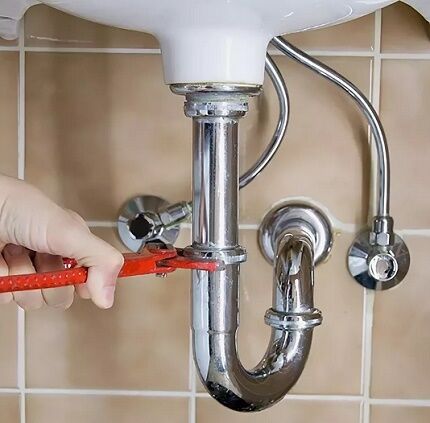
The correctness of the installation will be confirmed by the absence of leaks and good flow of liquid through the drain hole of the sink without any stagnation. If deficiencies are identified, they must be urgently corrected and checked again.
How to care for the siphon?
Any type of sink drain requires regular maintenance. It consists of inspecting for damage, thoroughly cleaning the product and thoroughly removing any blockages that have formed.
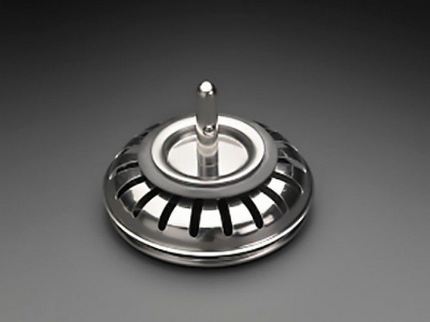
The complexity of the procedure is determined by the material and design. Corrugated siphons are cleaned only after complete disassembly, while in bottle siphons it is enough to unscrew and rinse the flask.
Some devices are easily pierced with a special tube. For cleaning purposes use chemical substances home-made or factory-made, ready-made compositions such as “Ruff”, “Phlox”. They should be used carefully, especially for plastic models.
To prevent the siphon from becoming so clogged, you can periodically flush it with hot water with the addition of a handful of citric acid. It is also worth paying attention to the fact that rubber seals wear out quickly. It is better to try to replace them approximately every six months.
Conclusions and useful video on the topic
Video #1. Features of the structure of plumbing fixtures for sinks:
Video #2. How to replace the siphon yourself:
Video #3.Details of assembling a siphon for a sink with overflow:
Independent installation of simple siphons on a sink is quite possible even for those who have very little experience in plumbing work. The main thing is to be patient, exercise caution and strictly follow the points specified in the manufacturer’s instructions.
To connect expensive models, it is more advisable to invite plumbers who have the necessary skills and a professional set of tools.
Please write comments in the block below, ask questions about the topic of the article, and post relevant photos. Tell us about how you changed the siphon under the kitchen sink with your own hands. It is possible that your information will be extremely useful to site visitors.




I believe that plastic siphons are the best option. Of course, if the space under the sink is open and the room has a cool design, then you will have to buy a beautiful metal siphon, but usually it is placed inside the cabinet.
Corrugated and bottle type have their advantages. In theory, a bottle is better because it can be unscrewed if necessary. But corrugation is more convenient in cases where there is not enough space under the sink.